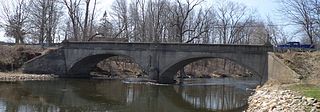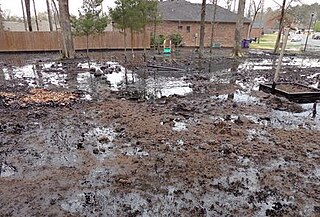
The Exxon Valdez oil spill was a major environmental disaster that made worldwide headlines in the spring of 1989 and occurred in Alaska's Prince William Sound on March 24, 1989. The spill occurred when Exxon Valdez, an oil supertanker owned by Exxon Shipping Company, bound for Long Beach, California, struck Prince William Sound's Bligh Reef, 6 mi (9.7 km) west of Tatitlek, Alaska at 12:04 a.m. The tanker spilled more than 10 million US gallons (240,000 bbl) of crude oil over the next few days.

Exxon Valdez was an oil tanker that gained notoriety after running aground in Prince William Sound, spilling her cargo of crude oil into the sea. On 24 March 1989, while owned by the former Exxon Shipping Company, captained by Joseph Hazelwood and First Mate James Kunkel, and bound for Long Beach, California, the vessel ran aground on the Bligh Reef, resulting in the second largest oil spill in United States history. The size of the spill is estimated to have been 40,900 to 120,000 m3. In 1989, the Exxon Valdez oil spill was listed as the 54th-largest spill in history.

The Trans-Alaska Pipeline System (TAPS) is an oil transportation system spanning Alaska, including the trans-Alaska crude-oil pipeline, 12 pump stations, several hundred miles of feeder pipelines, and the Valdez Marine Terminal. TAPS is one of the world's largest pipeline systems. The core pipeline itself, which is commonly called the Alaska pipeline, trans-Alaska pipeline, or Alyeska pipeline,, is an 800-mile (1,287 km) long, 48-inch (1.22 m) diameter pipeline that conveys oil from Prudhoe Bay, on Alaska's North Slope, south to Valdez, on the shores of Prince William Sound in southcentral Alaska. The crude oil pipeline is privately owned by the Alyeska Pipeline Service Company.

This Pulitzer Prize has been awarded since 1942 for a distinguished example of reporting on national affairs in the United States. In its first six years (1942–1947), it was called the Pulitzer Prize for Telegraphic Reporting – National.
The Enbridge Pipeline System is an oil pipeline system which transports crude oil and dilbit from Canada to the United States. The system exceeds 5,000 kilometres (3,100 mi) in length including multiple paths. More than 3,000 kilometres (1,900 mi) of the system is in the United States while the rest is in Canada and serves the Athabasca oil sands production facilities. Main parts of the system are 2,306-kilometre-long (1,433 mi) Canadian Mainline and 3,057-kilometre-long (1,900 mi) Lakehead System. On average, it delivers 1.4 million barrels per day of crude oil and other products to the major oil refineries in the American Midwest and the Canadian province of Ontario. The Canadian portion is owned by Enbridge, while the U.S. portion is partly owned by that company through Enbridge Energy Partners, LP, formerly known as Lakehead Pipe Line Partners and Lakehead Pipe Line Company.
Dilbit is a bitumen diluted with one or more lighter petroleum products, typically natural-gas condensates such as naphtha. Diluting bitumen makes it much easier to transport, for example in pipelines. Per the Alberta Oil Sands Bitumen Valuation Methodology, "Dilbit Blends" means "Blends made from heavy crudes and/or bitumens and a diluent, usually natural-gas condensate, for the purpose of meeting pipeline viscosity and density specifications, where the density of the diluent included in the blend is less than 800 kg/m3." If the diluent density is greater than or equal to 800 kg/m3, the diluent is typically synthetic crude and accordingly the blend is called synbit.

T. Christian Miller is an investigative reporter, editor, author, and war correspondent for ProPublica. He has focused on how multinational corporations operate in foreign countries, documenting human rights and environmental abuses. Miller has covered four wars—Kosovo, Colombia, Israel and the West Bank, and Iraq. He also covered the 2000 presidential campaign. He is also known for his work in the field of computer-assisted reporting and was awarded a Knight Fellowship at Stanford University in 2012 to study innovation in journalism. In 2016, Miller was awarded the Pulitzer Prize for Explanatory Journalism with Ken Armstrong of The Marshall Project. In 2019, he served as a producer of the Netflix limited series Unbelievable, which was based on the prize-winning article. In 2020, Miller shared the Pulitzer Prize for National Reporting with other reporters from ProPublica and The Seattle Times. With Megan Rose and Robert Faturechi, Miller co-won the 2020 award for his reporting on United States Seventh Fleet accidents.

The Prudhoe Bay oil spill was an oil spill that was discovered on March 2, 2006, at a pipeline owned by BP Exploration, Alaska (BPXA) in western Prudhoe Bay, Alaska. Initial estimates of the five-day leak said that up to 267,000 US gallons (6,400 bbl) were spilled over 1.9 acres (7,700 m2), making it the largest oil spill on Alaska's north slope to date. Alaska's unified command ratified the volume of crude oil spilled as 212,252 US gallons (5,053.6 bbl) in March 2008. The spill originated from a 0.25-inch (0.64 cm) hole in a 34-inch (86 cm) diameter pipeline. The pipeline was decommissioned and later replaced with a 20-inch (51 cm) diameter pipeline with its own pipeline inspection gauge (pig) launch and recovery sites for easier inspection.
Abrahm Lustgarten is an American investigative reporter, author, filmmaker and public speaker specializing in human adaptation to climate change, and an educator training journalists in cross-disciplinary communication about the climate crisis. He writes on staff for ProPublica and has worked with the New York Times Magazine.
Eric Nalder is an American investigative journalist based in Seattle, Washington. He has won two Pulitzer Prizes.

The Kalamazoo River oil spill occurred in July 2010 when a pipeline operated by Enbridge burst and flowed into Talmadge Creek, a tributary of the Kalamazoo River near Marshall, Michigan. A 6-foot (1.8 m) break in the pipeline resulted in one of the largest inland oil spills in U.S. history. The pipeline carries diluted bitumen (dilbit), a heavy crude oil from Canada's Athabasca oil sands to the United States. Cleanup took five years. Following the spill, the volatile hydrocarbon diluents evaporated, leaving the heavier bitumen to sink in the water column. Thirty-five miles (56 km) of the Kalamazoo River were closed for clean-up until June 2012, when portions of the river were re-opened. On March 14, 2013, the Environmental Protection Agency (EPA) ordered Enbridge to return to dredge portions of the river to remove submerged oil and oil-contaminated sediment.
This is a list of notable events relating to the environment in 2013. They relate to environmental law, conservation, environmentalism and environmental issues.

The 12 Mile Road–Kalamazoo River Bridge, also known as State Reward Bridge No. 53, is a filled-spandrel concrete arch bridge in Ceresco, Michigan, that carries 12 Mile Road over the Kalamazoo River. Built in 1920, it is listed on the National Register of Historic Places.

The 2013 Mayflower oil spill occurred on March 29, 2013, when the Pegasus Pipeline, owned by ExxonMobil and carrying Canadian Wabasca heavy crude from the Athabasca oil sands, ruptured in Mayflower, Arkansas, about 25 miles (40 km) northwest of Little Rock releasing about 3,190 barrels of oil. Approximately 3,190 barrels of oil and water mix was recovered. Twenty-two homes were evacuated. The United States Environmental Protection Agency (EPA) classified the leak as a major spill.

Inside Climate News is a non-profit news organization, focusing on environmental journalism. The publication writes that it "covers clean energy, carbon energy, nuclear energy and environmental science—plus the territory in between where law, policy and public opinion are shaped."

As the world's largest majority investor-owned oil and gas corporation, ExxonMobil has received significant amounts of controversy and criticism, mostly due to its activities which increase the speed of climate change and its denial of global warming.
Elizabeth H. McGowan is an American journalist and author. With David Hasemyer and Lisa Song, McGowan won the 2013 Pulitzer Prize for National Reporting for their report on the Kalamazoo River oil spill.
Lisa Song is an American journalist and author. She won the 2013 Pulitzer Prize for National Reporting, with David Hasemyer and Elizabeth McGowan, for their report on the Kalamazoo River oil spill. She works for ProPublica, reporting on the environment, energy and climate change.

Merav Ben-David is an Israeli-American ecologist, zoologist, and politician who is the chair of the Department of Zoology and Physiology at the University of Wyoming. She was the Democratic nominee in the 2020 United States Senate election in Wyoming, losing to former Congresswoman Cynthia Lummis in the general election. She ran for state representative from Wyoming's 46th District in 2022.














